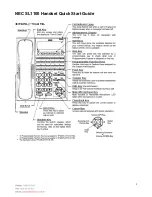
COLLISION ALERT SYSTEMS
APS-SUPPLY.COM
www.aps-supply.com
APS USA
610 Gateway Center Way, Suites J & K
San Diego, CA 92102 USA
P: 1 619 263 4164
F: 1 619 263 6814
APS Australia
Unit 1, 72 Kent Way
Malaga WA 6090 Australia
P: 61 (8) 9248 4419
F: 61 (8) 9248 4901
APS: Singapore
Colombia
Chile
Perú
Brasil
Object Detection Capability
The PreView® system is designed to supplement other safety practices and/
or devices, it is not to be the sole method of collision avoidance. The machine
operator is always the first line of defense when safely operating a vehicle.
The Wireless WorkSight PreView system can detect most objects within the
detection zone. However, there are some instances where objects can go
undetected. Obstacle size, shape, relative location, and composition are all
factors determining if, when and where an object is detected. The PreView
system operates by transmitting a pulse of very low power electromagnetic
energy. Any energy that strikes an object reflects a certain amount of this energy
back to the PreView sensor. If the returned energy is of sufficient magnitude, it
is used to indicate object presence and determine the object’s distance. While
the PreView system can resolve multiple objects, only the object closest to the
vehicle is reported to the operator display since it represents the most significant
collision threat.
The amount of energy returned is based on a few factors:
Size – a larger object usually reflects more energy than a smaller object.
Composition – a metal object typically reflects more energy than a non-
metallic object. A metallic object at the edge of the maximum detection
zone might be detected, whereas a wood object may not.
Scattering – a solid object reflects more energy that a non-solid object
such as tree branches, gravel, bushes, etc.
Shape – complex shapes cause energy to be returned in a very non-
uniform way. Very small variations or movement can change detection
status.
Angle – an object flat side perpendicular to the sensor will reflect more
energy than an object at an angle. See Figure 1 for an example of how
angle can affect return energy.


































